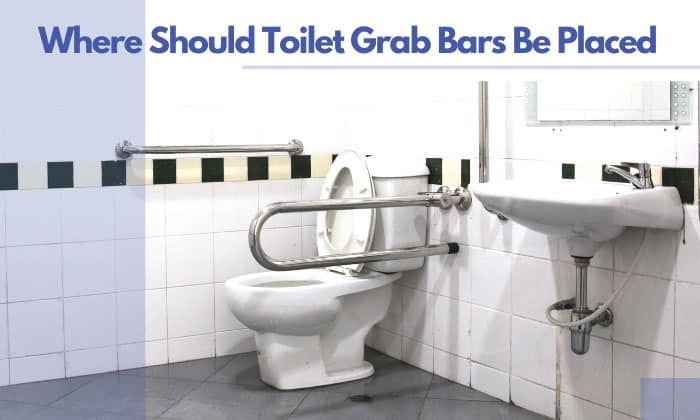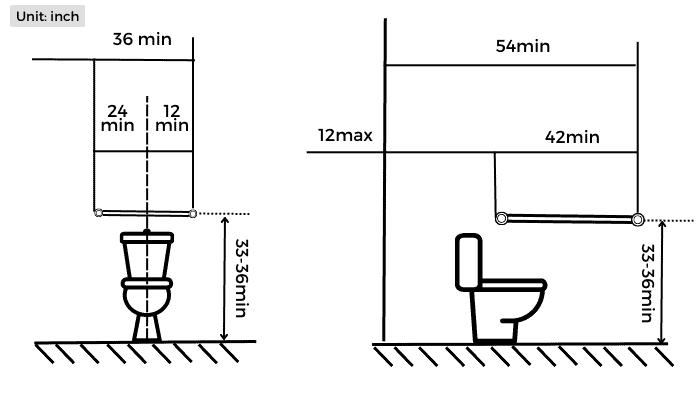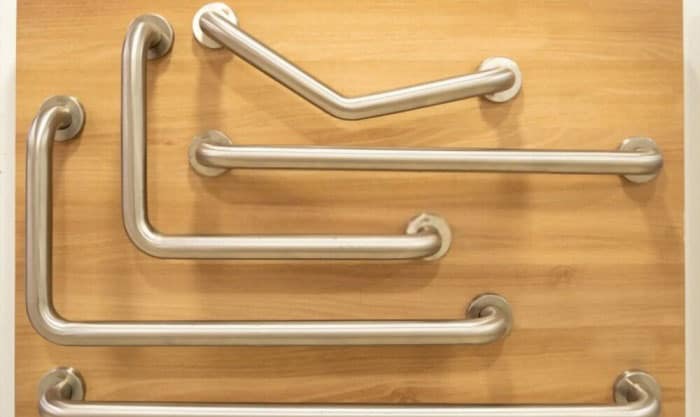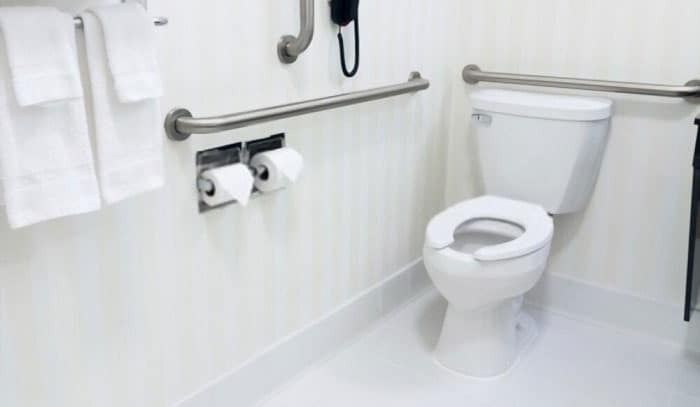Grab bars or safety rails are tools to support a person while sitting on or standing up from a toilet. With that said, where should toilet grab bars be placed?
The toilet grab bars placement will depend on two things: the classification of the place (e.g. commercial, residential, detention, or correction facilities) and the position of the toilet (e.g. corner, between walls, freestanding).
Table of Contents
Specific Instructions on Toilet Grab Bar Installation
Handicap bars, grab bars, or toilet assistance bars refer to the same material that supports individuals with a limited physical capacity to move around and use facilities like the toilet.
Grab bars for toilets adhere to the ADA requirements or the Americans with Disabilities Act of 1990, which promotes inclusivity for people with disabilities by ensuring they have the same opportunities in public places or even private ones that are open for general use.
General Requirements
The information in this part of the article was taken directly from the 2010 ADA Standards for Accessible Design.
If you wish to view the original source, you may do so by visiting ADA.gov.
1. Spacing
The ADA grab bar installation guide requires the following spacing:
- The required space between the wall and the grab bars is 1 ½ inches (38 mm).
- A minimum of 1 ½ inches (38 mm) space is required between the bars and projecting objects below.
- In terms of the space between the grab bars and the projecting objects from above, a minimum of 12 inches (305 mm) is permitted.
Projecting objects are protruding objects that can hinder a person from grabbing the bars when necessary. That is why it is better not to have protruding objects at all near the grab bars so it will be easier for the elderly, weakened, or disabled individuals.
2. Diameter, Dimension, and Perimeter
Since there are circular and non-circular grab bars, the ADA provided the recommended measurements for each.
- For designs with circular cross sections, the required minimum diameter is 1 ¼ inches (=32 mm) and a maximum of 2 inches (=51 mm).
- For designs with non-circular cross sections, the maximum cross-section distance allowed is 2 inches (=51 mm). For the perimeter dimension, it should be a minimum of 4 inches (=100 mm) and a maximum of 4.8 inches (=120 mm).
3. Position
The required standard height for grab bars was also discussed in the ADA standards for efficient and comfortable use.
- The grab bars should be installed horizontally and with a distance from the floor surface of a minimum of 33 inches (=840 mm) and a maximum of 36 inches (=915 mm).
- When it comes to water closets for children, the height of the toilet grab bars from the floor should be a minimum of 18 inches (=455 mm) and a maximum of 27 inches (=685 mm).
4. Structural Strength
The grab bar itself and the structure of installation should be strong enough to handle human weight thus, the ADA requires the following:
- The grab bars should be able to handle 250 pounds of force.
- The walls should be reinforced to handle the grab bar installation and the weight it will carry.
- Within the grab bars’ fittings, they should also not rotate.
5. Placing the Grab Bars
The ADA standards require two locations for grab bar bathroom placement: the rear and the side wall, and they have provided a placement diagram for this purpose as well which we summarized below.
At what angle should a grab bar be installed? The ADA requires them to be installed horizontally. Although vertical grab bars are also available but are only required depending on the building code.
6. Side Wall
The length of the grab bar next to the toilet should be a minimum of 42 inches (1,056 mm).
The installation point of the bar should be 12 inches (305 mm) maximum from the rear wall.
Also, the length of the bar should extend at a minimum of 54 inches (=1,370 mm) from the rear wall.
7. Rear Wall
The length of the grab bar behind the toilet should be a minimum of 36 inches (=915 mm).
One side of this grab bar should extend from the water closet’s centerline at a minimum of 12 inches (305 mm). The other side should extend at a minimum of 24 inches (=610 mm).
Installing Grabs Bars in Non-commercial or Private Properties
The 2010 ADA Standards for Accessible Design clearly stated that:
- The installation of grab bars in residential dwellings is not required, although owners may do so if they prefer.
- The installation of grab bars in detention, correction, or any facilities designed to prevent accidents or suicide.
If you wish to install grab bars in your home bathroom, you do not need to adhere to the ADA standards but we recommend using it as your guide with consideration to your personal preferences such as your:
- Height;
- Personal necessities and;
- Interior preferences such as the type of grab bar that you like.
In this section, we listed different bathroom layouts and where to place the toilet grab bars.
- Corner layout – this is the usual layout where we will place a grab bar on the side and rear wall.
- Between-the-walls layout – this is where the placement of grab bars is around the toilet, specifically on the two side walls and the rear wall.
- Freestanding layout – this is where there are no walls near the toilet and the grab bars we can use are: wall-to-floor, a sidebar with an outrigger, or wall-to-floor with an outrigger.
What Are the Types of Grab Bars?
There are different types of grab bars for toilet support and some of them are the following:
- Wall-mounted. This is installed to walls using anchors and screws.
- Suction. This utilizes suction cups to attach to walls and is recommended for permanent use only, as it is not as secure as the wall-mounted type.
- Folding. This is preferable if you are saving space as the grab bar will be flippable up or down.
- Free-standing. This is commonly utilized if the walls are too far from the toilet.
In terms of style, we also have the following choices:
- Straight
- Wave. This has a slight curve compared to the horizontal or vertical straight bars.
- Textured. This provides a non-slip grip.
- 2-in-1. The main purpose is a grab bar combined with an additional feature such as a towel or toilet paper rack.
Ways to Install Grab Bars
The installation of grab bars will depend on the type. For this, we will use wall-mounted bars as an example.
Steps:
- Take the materials out of the grab bar kit and determine the place of mounting.
- Mark the specific part of the wall using a pencil.
- On the marked position, use the flange of the bar to mark the places to screw.
- Drill the marks from the flange and proceed to screw the grab bar.
- You may also seal the area around the flange with a silicone caulk to avoid water from seeping through.
Frequently Asked Questions (FAQs)
Should Grab Bars Be Vertical or Horizontal?
The 2010 ADA Standards for Accessible Design requires us to install horizontal grab bars in toilets open to the general public.
Installing vertical grab bars, on the other hand, will depend on the building code or the preference of the owner if the place is a residential dwelling.
How Much Does It Cost to Install Grab Bars?
It takes not less than $100 to install a single grab bar, depending on the cost of the actual product and the labor fee, if any.
Can I Install Grab Bars by Myself?
Yes, you can install grab bars by yourself. There are many instructions on the internet that guide people to DIY put up their grab bars.
However, you may also ask for the help of a professional or someone you know who has experience in construction or mounting safety devices if you are unsure of what to do.
Conclusion
Grab bars support an individual in carrying his own weight in places such as the bathroom. In this case, where should toilet grab bars be placed? Adhering to the 2010 ADA Standards for Accessible Design, they are commonly placed on the side and rear walls.
The length, distance of the grab bars from the surface and other projecting objects, and dimensions of the grab bars themselves are strictly considered. However, in terms of private places such as homes, the installation of this safety device is at the discretion of the owner.

I’m Paulk Webb, and I work as a writer for Saveourwaterrebates. I’m happy to put in the time and effort to conduct market research to identify the most pressing issues faced by households concerning their plumbing. Feel free to check out our guides to get the most informed recommendations for how to solve your problems.





